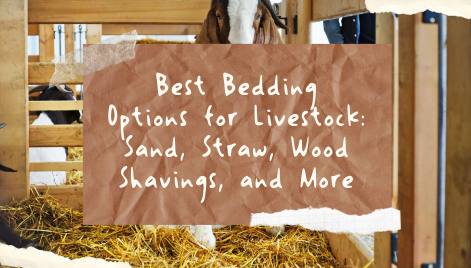
Best Bedding Options for Livestock: Sand, Straw, Wood Shavings, and More
04/11/2025
Providing proper bedding for your livestock is essential for their health, comfort, and overall well-being. The right bedding material helps absorb moisture, control odors, and provide cushioning, reducing stress on animals’ joints and hooves. But with so many options available, how do you know which is best for your farm?
In this guide, we’ll explore the most popular bedding choices—including sand, straw, wood shavings, and more—so you can find the right fit for your livestock and management style.
1. Sand: A Clean and Low-Maintenance Option
Sand is a popular bedding choice, especially for dairy cows and horses. It provides excellent drainage, reduces bacterial growth, and doesn’t retain moisture like organic materials.
Pros:
- Provides a soft, supportive surface for animals, reducing the risk of joint injuries
- Drains well, keeping animals dry and reducing ammonia buildup
- Less likely to harbor bacteria compared to organic bedding
- Long-lasting and doesn’t need frequent replacement
Cons:
- Can be heavy and difficult to clean or remove
- Requires proper drainage to prevent compacting and hardening
- Not ideal for colder climates, as it does not provide much insulation
Best For:
- Dairy cows, horses, and pigs
- Farms with good drainage systems
2. Straw: A Traditional and Cost-Effective Choice
Straw has been used for centuries as bedding for livestock, including cattle, horses, goats, and sheep. It’s widely available, affordable, and offers good insulation in cold weather.
Pros:
- Readily available and cost-effective
- Provides good insulation for animals in colder climates
- Can be composted and repurposed as manure
Cons:
- Absorbs moisture slowly, which can lead to odor and bacteria buildup
- Needs frequent replacement to maintain cleanliness
- Some animals may eat it, reducing its effectiveness as bedding
Best For:
- Horses, cattle, goats, and sheep
- Colder climates where insulation is important
3. Wood Shavings: A Soft and Absorbent Option
Wood shavings are commonly used for horses, poultry, and small livestock because they are soft, absorbent, and relatively easy to manage. Pine and cedar shavings are the most popular choices.
Pros:
- Highly absorbent, reducing odor and moisture buildup
- Provides a soft, cushioned surface for animals
- Breaks down well in compost piles
Cons:
- Some wood types (like black walnut) can be toxic to certain animals
- Needs regular cleaning to prevent dust buildup
- Can be more expensive than straw in some regions
Best For:
- Horses, poultry, and small livestock like rabbits and goats
- Stalls, coops, and confined spaces
4. Sawdust: Affordable and Highly Absorbent
Sawdust is a fine, powdery bedding material that provides excellent moisture absorption. It is commonly used in poultry houses, pig pens, and horse stalls.
Pros:
- Highly absorbent, keeping animals dry
- Readily available and inexpensive in many areas
- Can be composted and used as fertilizer
Cons:
- Dusty, which can cause respiratory issues in some animals
- Can cake and form hard layers if not properly managed
- May contain wood particles that irritate animals’ skin or hooves
Best For:
- Poultry, pigs, and horses
- Well-ventilated barns and stalls
5. Peat Moss: A Natural and Odor-Reducing Choice
Peat moss is gaining popularity as a livestock bedding material due to its excellent moisture absorption and odor control properties.
Pros:
- Excellent at absorbing moisture and controlling ammonia smells
- Reduces bacterial growth and improves hygiene
- Can be composted and used as a soil amendment
Cons:
- Can be more expensive than traditional bedding options
- Requires frequent fluffing to maintain effectiveness
- Not as widely available as straw or wood shavings
Best For:
- Horses, dairy cows, and poultry
- Farmers looking for an eco-friendly bedding solution
6. Recycled Paper: An Eco-Friendly Bedding Option
Shredded or pelleted recycled paper is an alternative bedding material that provides good absorbency while being environmentally friendly.
Pros:
- Highly absorbent and helps control odor
- Soft and comfortable for animals
- Made from recycled materials, reducing waste
Cons:
- Can become soggy quickly if not changed frequently
- More expensive than traditional options in some areas
- Paper-based bedding may contain inks or chemicals if not sourced properly
Best For:
- Poultry, horses, and small livestock like rabbits and guinea pigs
- Farms looking for sustainable bedding solutions
Choosing the Best Bedding for Your Farm
When selecting the right bedding for your livestock, consider the following factors:
Animal Type: Some bedding materials are better suited for certain animals. For example, horses and poultry do well with wood shavings, while cows and pigs benefit from sand or straw.
Absorbency Needs: If moisture control is a priority, highly absorbent options like sawdust, peat moss, or recycled paper may be ideal.
Climate Conditions: In colder climates, straw provides better insulation, while sand works well in warmer regions.
Ease of Cleaning: Some materials, like sand, require less frequent replacement but can be harder to clean. Others, like straw, need regular replacement but are easy to manage.
Availability and Cost: Consider what is readily available in your area and whether it fits within your budget.
Shop C&C Farm and Home
Choosing the best bedding option for your livestock depends on your specific farm setup, climate, and management preferences. Whether you opt for the traditional warmth of straw, the absorbency of sawdust, or the cleanliness of sand, each option has its unique benefits.
For all your livestock bedding supplies, visit C&C Farm and Home! We carry high-quality materials to keep your animals comfortable, dry, and healthy.